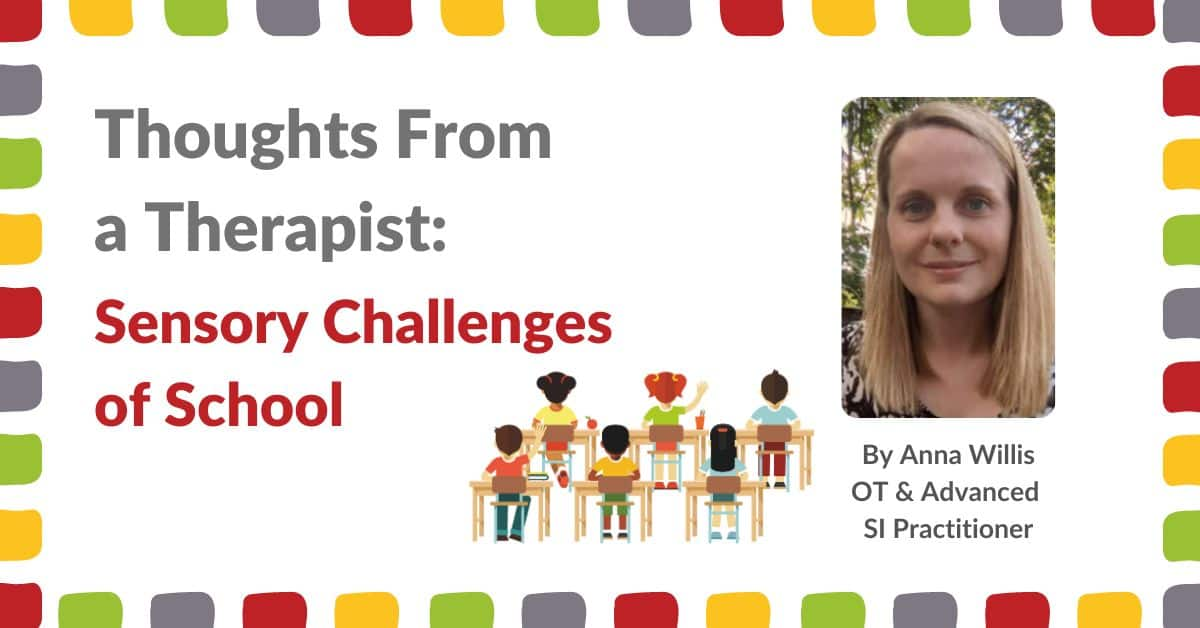News: Thoughts from a Therapist: Managing the Sensory Challenges of School
By Anna Willis, Active Play Therapies

In this month’s Thoughts from a Therapist blog, Anna Willis takes a look at the sensory challenges students face in the school environment.
Back to school, we go! It’s the start of a new term and I don’t think there’s any child or young person who confidently walks in without a care in the world (or is there?!), but where the level of challenge lies is on a spectrum from mild wobble to unmanageable levels of overwhelm.
The sensory challenges of school can be vast. Just off the top of my head, here are some of the key ones:
- Smell: corridors, dining halls, staff perfume, coffee, other children’s laundry and shampoo on their clothes and skin, classroom materials (glue, paint, pencil sharpenings), bathrooms.
- Visual: corridor displays, dangly things from ceilings, busy classrooms, children running in playgrounds, messy resources, struggling to look up and down at the whiteboard then to paper.
- Sounds: others talking, squeaky chairs rocking, pens clicking, hand dryers, shouting (children and adults), others eating, coughing, sneezing.
- Touch: uniform, scratchy labels, stiff shoes, being bumped into, scratchy carpets (sitting on the floor), uncomfortable chairs or benches.
- Movement: having to sit still! Navigating around busy classrooms, moving in between furniture, getting enough movement in short break times, balance challenges in PE lessons, staying on chairs or sitting upright on carpeted floors.
- Praxis challenges: writing, drawing, manipulating objects, zips on coats, shoelaces, organising and keeping hold of belongings, remembering homework, managing their own toileting, handling packets in lunchboxes or cutlery with hot meals.
A lot of this is in addition to the academic and social challenges of the day. I recently attended some training focused on supporting autistic individuals with their energy regulation (rather than emotional) and they mentioned a great way to support self-advocacy for young people is for them to write their own letters or report to their teachers and be empowered to take ownership and let others know their needs and what helps them. It’s such a simple idea but so powerful.
A suggested opener would be “I recently have completed a block of therapy and these are some things I’ve learnt about myself:”. I think this would be a fabulous way to start the term – having children and young people, where able, to write their own letters to sum up what their sensory challenges in the environment are and what helps them.
Sending you all lots of positive back to school energy!
Anna
PS You may also be interested in taking a look at our Sensory Inclusive Schools (SIS) services. SIS provides comprehensive support to schools seeking to enhance their inclusive practices. Our training helps schools understand and work with a student's unique sensory profile, to unlock barriers to learning and prevent challenges like reduced educational attainment and school refusal.
We can train and support staff to support all students’ unique sensory profiles, for improved educational outcomes and a better school experience for students and have designed bespoke packages for Teachers & Support Staff, SENCos and Professionals working in schools. You can find out more about our SIS services here.

